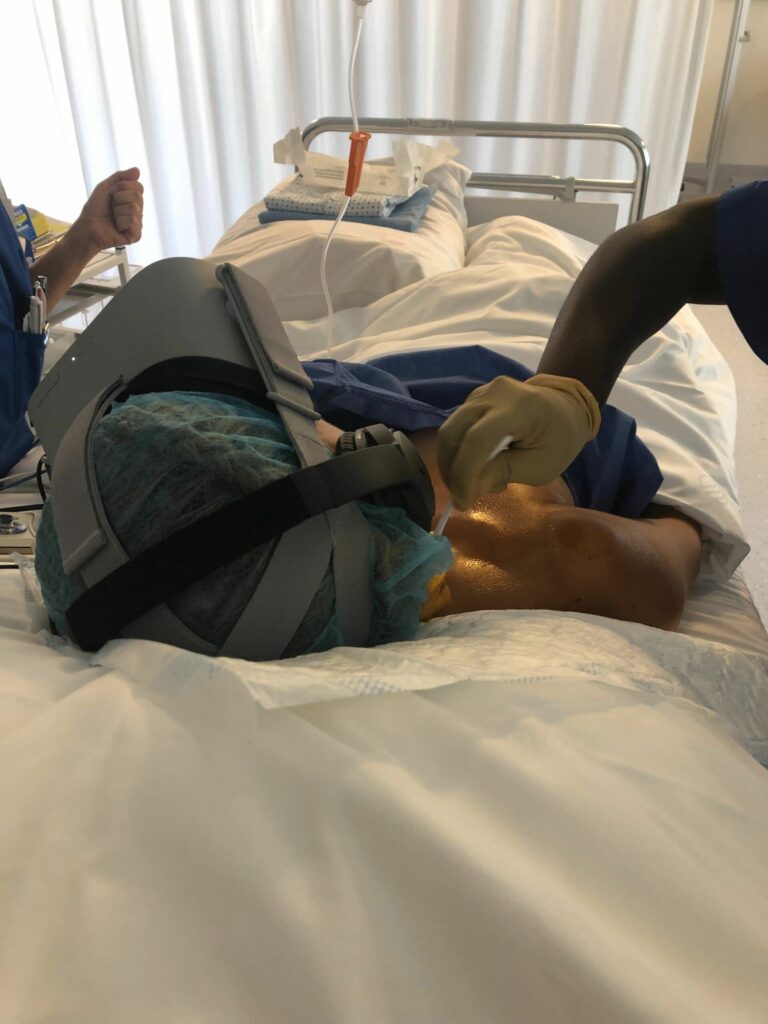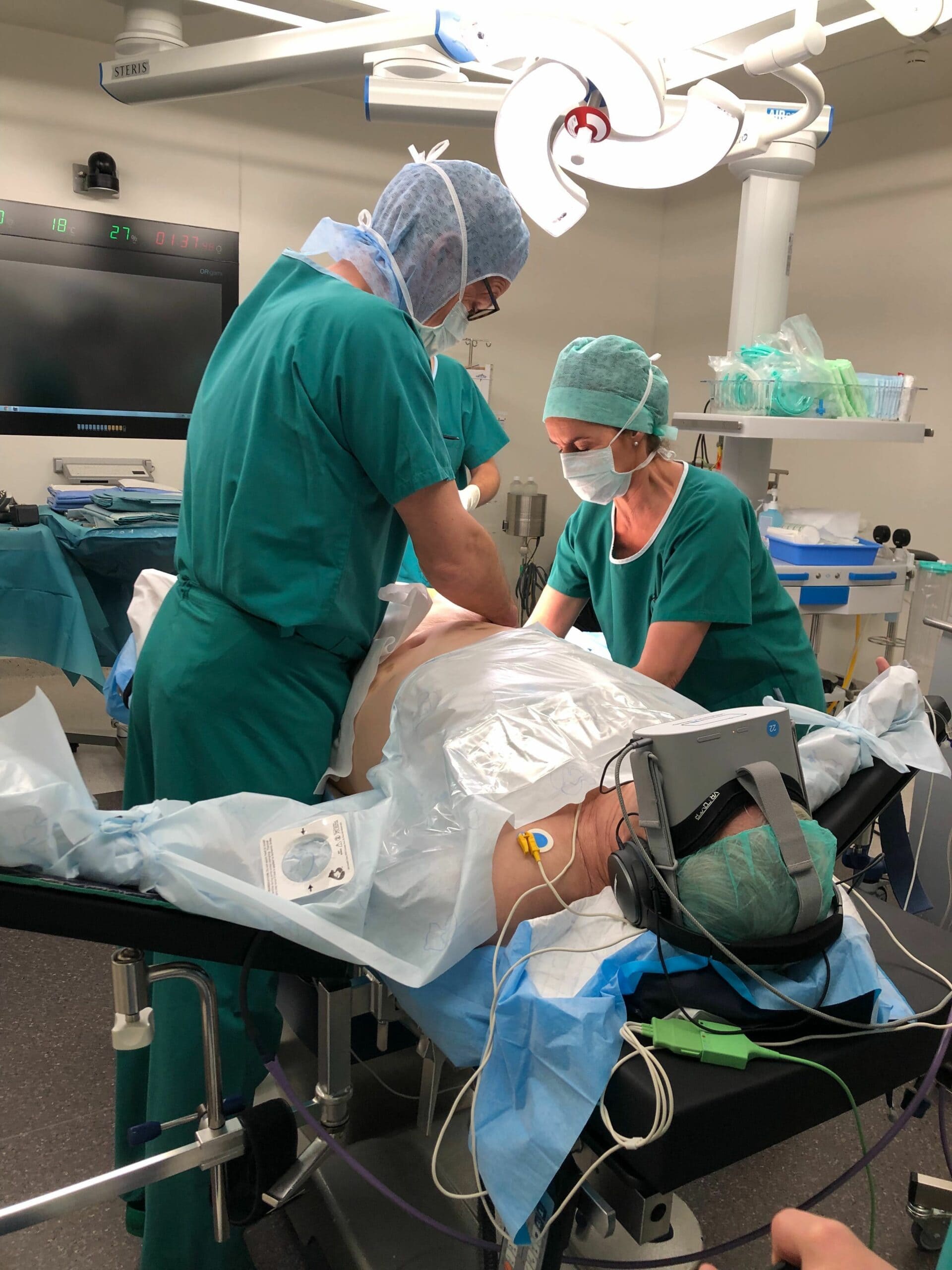Operated under loco-regional anesthesia (LRA), a patient is totally conscious during the surgical procedure. The main advantage is the reduction of the risks and inconveniences associated with general anesthesia, such as nausea, allergic reactions, or post-operative recovery difficulties. What is the disadvantage? The patient can be afraid about seeing and hearing everything in the operating room and that can be a source of anxiety and discomfort for him. This explains the fact that loco-regional anesthesia is often accompanied by sedation with tranquilizing drugs. Therefore, how to avoid, or at least reduce this anxiolytics intake? Virtual reality sedation is maybe the solution!
Locoregional anesthesia, a successful procedure
The different types of LRA
For several years now, local-regional anesthesia has been experiencing significant growth in France. This is mainly due to the development of echo-guidance, which is gradually replacing neurostimulation, particularly for vascular punctures. Indeed, echo-guided puncture leads to fewer complications and failures concerning percutaneous accesses (hematomas, thromboses, pseudoaneurysms, infections, nerve paralysis, etc.). This is particularly the case with ultrasound, which allows needle-guided puncture at a thickness of less than 5-10 mm.
Thus, different types of local-regional anesthesia have been developed. In the case of spinal anesthesia, the injection of local anesthetics is made in the patient’s back with a needle. Its caliber depends on whether it is an epidural or spinal anesthesia (a thinner needle is used in the second case).
In addition, surgical procedures performed under peripheral nerve blocks are becoming more and more common, due to the development of ambulatory management. In the context of peripheral (or truncular) anesthesia, the injection can take place in the following plexus blocks :
- The crural (or femoral) block, i.e. in the groin of the crural nerve. This anesthesia is suitable in the case of knee arthroscopies or varicose vein surgery.
- The humeral (or axillary) block, also known as the armpit or upper arm. This injection is particularly effective for anesthetizing the patient’s forearm, elbow, wrist or hand.
Good practice for loco-régional anaesthesia
Thus, anesthetic agents injected into a peripheral motor block (or muscle group), temporarily paralyzes it by blocking musculo-nervous conduction. As this practice is relatively recent and adaptable to different cases of application, recommendations are regularly published on this subject. In France, the SFAR (French Society of Anesthesia and Resuscitation) regularly publishes rules of good practice for anesthesiologists.
The SFAR’s latest recommendation dates from 2018. Published in collaboration with SOFMER (French Society of Physical Medicine and Rehabilitation), it deals with the application of local-regional anesthesia in PRM (Physical and Rehabilitation Medicine), and includes in particular:
- A list of indications and contraindications about the products to be used, according to the block concerned.
- Pieces of advice about the material and medical support, the type of efficiency control to be carried out, the preparation of the patient (analgesia, communication) and the training of the PRM doctor practicing.
In this specific case, the SFAR’s referring physicians are Doctors Olivier Choquet (Montpellier), Philippe Cuvillon (Nimes), Dominique Fletcher (Paris), Valeria Martinez (Paris), Lionel Velly (Marseille).
Advantages of loco-regional anaesthesia versus general anaesthesia
Although it is still requested by the most anxious patients, general anesthesia is no more a necessity today (except for deep surgical interventions). Gradually being replaced by loco-regional anesthesia, the LRA has many advantages over general anesthesia :
- faster recovery of the patient ;
- the reduction of the risks of complications and undesirable side effects, linked to the injection of preoperative anesthetic and analgesic agents (morphine, fentanyl or midazolam): nausea, vomiting, cardiac and respiratory complications, allergies…
Also, local-regional anesthesia is necessary in the cases below, for which general anesthesia cannot be practiced :
- with a patient with a serious cardiac or respiratory condition;
- for very old patients;
- with persons for whom a state of total unconsciousness is unnecessary or even harmful (childbirth).

Locoregional anesthesia: virtual reality or medicinal sedation?
Medicated sedation and local-regional anesthesia
The use of medicinal analgesics is almost automatically associated with local anaesthesia for many reasons:
- Tranquilize and relax the patient before the operation.
- To bring comfort to the patient during the surgical procedure, who may be disturbed by unpleasant sounds.
However, premedication can induce side effects (nausea or allergic reactions). Indeed, intravenous sedation involves strong opioids (fentanyl), as well as benzodiazepines (midazolam), which can lead to respiratory depression, especially with patients suffering from sleep apnea. The combination of opioids and benzodiazepines may also contribute to postoperative delirium, especially with the oldest patients.
Locoregional anestehsia with virtual reality sedation
From then on, virtual reality appears as an effective solution to reduce drug sedation and its undesirable side effects. By what means?
Therapeutic virtual reality headsets, such as Healthy Mind tools, can be worn by patients before, during and after surgery. Compact, comfortable and easy to use, Healthy Mind’s virtual reality headsets are perfectly adapted to the patient’s lying position, within surgical or perioperative medical interventions.
Developed with neuroscience specialized doctors as well as sophrologists and hypnotherapists, the Healthy Mind virtual reality software offers a 3D virtual immersion to the patient, based on several principles:
- an hypnotic speech and breathing exercises, to deeply relax the patient;
- relaxing images and sounds, to cut the patient off from his medical and surgical environment.
Therefore, the use of therapeutic virtual reality sedation instead of drug sedation has several advantages:
- It reduces pre-operative medication intake and the risk of side effects (allergies, nausea, etc.).
- The patient, conscious and lucid during the intervention, is therefore actively involved in his care process.
- It separates the patient from his/her medical environment: the patient doesn’t perceive anything of what is happening around him or her, both visually and audibly.
The beneficial effects of virtual reality: encouraging studies
Virtuel reality to reduce medical pain
Several studies tend to show that virtual reality is an effective diversion tool to reduce the pain associated with dressing changes, catheter placement, or other outpatient surgery procedures. Thus, it appears to be an effective substitute for premedication.
In the study “Virtual reality distraction decreases routine intravenous sedation and procedure-related pain during preoperative adductor canal catheter insertion: a retrospective study”, published in the Korean Journal of Anesthesiology in 2017, virtual reality distraction is a non-pharmacological method used to reduce sedative consumption during peritoneal, perineural and perineal catheter insertion. After testing virtual reality on two groups of anesthetized patients, it appears that patients with virtual reality glasses and headphones have benefited from several advantages:
- a reduction of pharmacological intravenous sedation (fentanyl and midazolam) ;
- a reduction of pain;
- no side effects (dizziness, nausea, vomiting, side effects).
Furthermore, the “Annual Review of CyberTherapy and Telemedicine” of the Interactive Media Institute (2009) demonstrates the reduction of anxiety through virtual reality in ambulatory surgery. Indeed, virtual reality appears to be effective in reducing pain in dental surgery, prostate thermo-surgery, and in reducing the symptoms of cancer chemotherapy.
Virtual reality as a medical distraction
Finally, the study “Virtual Reality for PEripheral Regional Anesthesia (VR-PERLA Study)”, published in the Journal of Clinical Medicine in 2020, also demonstrates the reduction of anxiety through virtual reality in ambulatory surgery. According to this study, as a pre-operative distraction offered to patients operated on in the ambulatory surgery unit, virtual reality appears to be “one of those effective diversion methods that has proven its benefits, particularly in the care of burn patients, breast cancer patients and pediatric patients”. This finding is based on a study conducted in upper limb patients undergoing peripheral nerve block surgery in January 2019. Two groups of patients were tested in this test: one with a virtual headset, the other without. The results of this study demonstrate that immersion in a relaxing virtual environment, as a complement to regional peripheral anesthesia in the operating room, can :
- improves patient satisfaction;
- reduce perioperative anxiety through hemodynamic stabilization effects;
- be totally accepted and used by the medical-surgical team.
Thus, loco-regional anesthesia is increasingly recommended by health professionals, and choosed to general anesthesia by patients. For the most reticent, virtual reality then appears as an effective tool to convince them to avoid general anesthesia, or even to avoid the drug sedation of loco-regional anesthesia. The benefits of virtual reality sedation are numerous: better post-operative recovery of the patient, reduction of pain and anxiety… Virtual reality headsets are now fully adapted for hospital and medical use. For more information on therapeutic virtual reality, please discover our Healthy Mind solutions and contact our team!

Bibliography :
- Pandya, P.G. (2017). Virtual reality distraction decreases routine intravenous sedation and procedure-related pain during preoperative adductor canal catheter insertion: a retrospective study. Korean Journal of Anesthesiology, 70(4), pp. 339-445.
- Mosso, J.L. (2009). A Second Life for Telehealth: Prospects for the Use of Virtual Online Worlds in Clinical Psychology. Annual Review of CyberTherapy and Telemedicine, 6, pp. 140-145.
- Alaterre, C. (2020). Virtual Reality for PEripheral Regional Anesthesia (VR-PERLA Study). Journal of Clinical Medicine, 9(215), pp. 1-15.







